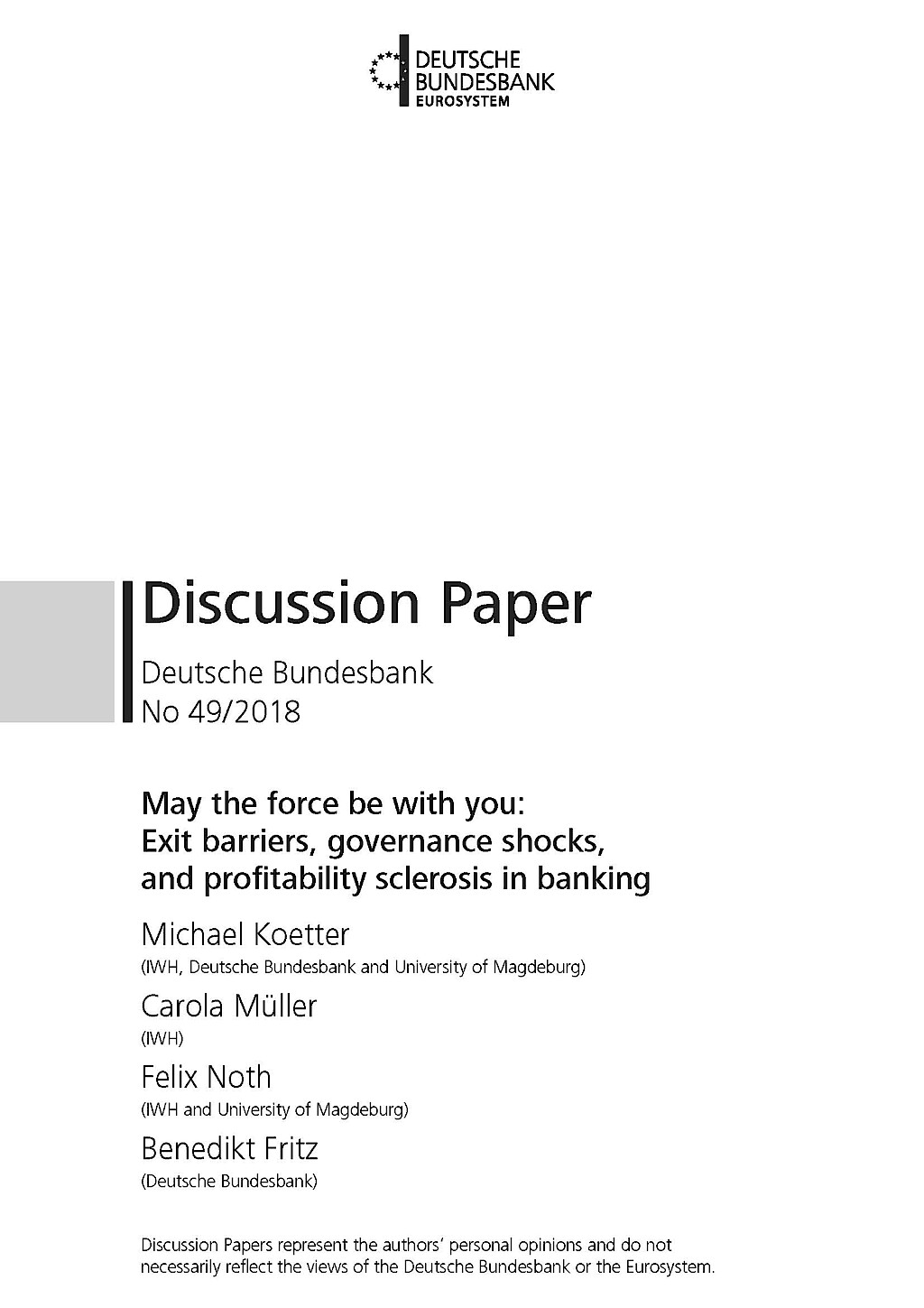Bank profitability increases after eliminating consolidation barriers
Government support of the ailing Norddeutsche Landesbank on the order of 3.5 billion Euros appears in a different light if you consider that (1) with more than 1,800 banks, Germany has more credit institutions than any other country in Europe and (2) many banks only generate very low profits, which as a consequence (3) can pose a danger to financial stability. The main reason is that sustained sclerotic profitability raises risk-taking incentives of banks.
In Germany, there are too many banks scrambling for increasingly smaller revenues. Structurally poor profitability in the sector can put financial stability at risk.
A team from the Halle Institute for Economic Research (IWH) investigated a special-case scenario. In Germany, when districts are amalgamated as a result of territorial reforms, their savings banks must also amalgamate. This ‘merger shock’ permits the isolation of the causal connection between the consolidation of regional banks and the development of their profitability potential after such a transaction, and to separate this from other factors such as the regional economic situation. 1,627 savings bank mergers between 1993 and 2015 were investigated. The researchers compared the newly created institutions with cooperative banks that had either merged voluntarily, or not merged at all. The results showed that the savings banks subjected to compulsory mergers increased their profitability by 5–6 percentage points compared with cooperative banks. Against the backdrop of an average return on equity of 8 percentage points, this magnitude is economically significant. The effect lasts for up to eight years after the merger. The essential drivers of this higher profitability are lower equity investment, easily increased credit risks, and lower operating costs.
Completing the European banking union by establishing a fully mandated deposit guarantee system is an important step towards fewer cross-border consolidation barriers
The researchers also looked at the consequences of a compulsory merger for the bank’s corporate customers relative to those of non-forced savings banks mergers. Corporate cost of credit fell by 0.25 percentage points and these customers connected to forced mergers invested up to 50% more in the three years following the bank merger. In the longer term they increased employment between 1% and 2%.
Michael Koetter, Head of the Department of Financial Markets at IWH and co-author of the study, draws the following conclusions from the survey. “In Germany, there are too many banks scrambling for increasingly smaller revenues. Structurally poor profitability in the sector can put financial stability at risk.” Moreover, says Koetter, because digitalisation makes banking transactions easier, fewer financial institutions are needed. Excessive pressure to succeed resulting from overcapacity increases the risk of a new financial crisis which, once again, could cost a lot of taxpayers’ money.
Koetter therefore pleads for a reduction in the political barriers to bank mergers. “We need more intelligent and courageous consolidation that crosses borders – borders in Europe and the rest of the world, but also the national borders between the pillars of our banking system as it has evolved historically. It is too fragmented for today’s demands.” Up to now, mergers between the three pillars of the German banking system (savings banks, cooperative banks, commercial banks) have been forbidden. “Completing the European banking union by establishing a fully mandated deposit guarantee system is an important step towards fewer cross-border consolidation barriers,” says Koetter. Such an elimination of merger frictions would render dearly needed pan-European mergers involving German banks more attractive for foreign investors. In Koetter’s view an international solution instead of the discussed merger between Deutsche Bank and Commerzbank would make more sense. “Experience shows that, in the banking world too, you can’t make a two-legged sprinter out of two one-legged walkers.”
Publications
Koetter, Michael; Müller, Carola; Noth, Felix; Fritz, Benedikt: May the Force be with You: Exit Barriers, Governance Shocks, and Profitability Sclerosis in Banking, in: Deutsche Bundesbank Discussion Paper 49/2018, Frankfurt am Main 2018.
Koetter, Michael: Es ist nicht genug für alle da [It’s not enough for everyone]. Op-ed for: Süddeutsche Zeitung, 1st April 2019, p. 16.
Whom to contact
For Researchers

Vice President Department Head
If you have any further questions please contact me.
+49 345 7753-727 Request per E-MailFor Journalists

Internal and External Communications
If you have any further questions please contact me.
+49 345 7753-832 Request per E-MailIWH list of experts
The IWH list of experts provides an overview of IWH research topics and the researchers and scientists in these areas. The relevant experts for the topics listed there can be reached for questions as usual through the IWH Press Office.
Related Publications

May the Force Be with You: Exit Barriers, Governance Shocks, and Profitability Sclerosis in Banking
in: Deutsche Bundesbank Discussion Paper, 49, 2018
Abstract
We test whether limited market discipline imposes exit barriers and poor profitability in banking. We exploit an exogenous shock to the governance of government-owned banks: the unification of counties. County mergers lead to enforced government-owned bank mergers. We compare forced to voluntary bank exits and show that the former cause better bank profitability and efficiency at the expense of riskier financial profiles. Regarding real effects, firms exposed to forced bank mergers borrow more at lower cost, increase investment, and exhibit higher employment. Thus, reduced exit frictions in banking seem to unleash the economic potential of both banks and firms.



